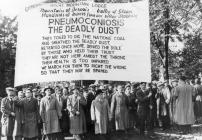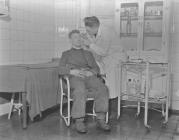8. Industrial Disease in the Coalfield: The Deadly Dust
Items in this story:
Pneumoconiosis (also known as black lung and miners’ lung) and silicosis were lung diseases caused by dust, they led to the disability and the early death of miners.
From 1933 to 1948, 17,000 miners in Wales had left their underground work due to pneumoconiosis or silicosis.
Great Mountain Lodge members at Miners’ Gala, Sophia Gardens, Cardiff, 20th century (DNCB/14/1/42)
In 1928 coalminers were eligible for silicosis compensation. Many coal miners were refused compensation as this was not the disease they had.
Extract from Pneumoconiosis and Silicosis Insurance Scheme Register, 1945-1952 (DNCB/3/5/1)
An investigation by the Medical Research Council led to the Coalmining Industry (Pneumoconiosis) Compensation Scheme in 1943. This meant that compensation could be paid for both diseases.
Garw First Aid Room, Man having eye examined, 13 Feb 1951 (DNCB/14/4/58/6)
Not all coal industry diseases were caused by dust. Nystagmus, a disease of the eye caused by work in low light conditions, affected 199,831 miners in the UK between 1908 and 1938.


